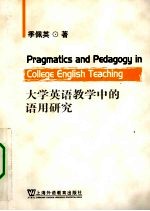图书介绍
大学英语教学中的语用研究【2025|PDF|Epub|mobi|kindle电子书版本百度云盘下载】

- 季佩英著 著
- 出版社: 上海:上海外语教育出版社
- ISBN:9787544608732
- 出版时间:2008
- 标注页数:252页
- 文件大小:24MB
- 文件页数:267页
- 主题词:语用学-应用-英语-语言教学-高等学校
PDF下载
下载说明
大学英语教学中的语用研究PDF格式电子书版下载
下载的文件为RAR压缩包。需要使用解压软件进行解压得到PDF格式图书。建议使用BT下载工具Free Download Manager进行下载,简称FDM(免费,没有广告,支持多平台)。本站资源全部打包为BT种子。所以需要使用专业的BT下载软件进行下载。如BitComet qBittorrent uTorrent等BT下载工具。迅雷目前由于本站不是热门资源。不推荐使用!后期资源热门了。安装了迅雷也可以迅雷进行下载!
(文件页数 要大于 标注页数,上中下等多册电子书除外)
注意:本站所有压缩包均有解压码: 点击下载压缩包解压工具
图书目录
CHAPTER 1 INTRODUCTION1
1.1 Globalization of English1
1.2 College English teaching in China2
1.3 Information about College English textbook writing in China5
1.4 Aim of the study6
1.5 Significance of the study9
1.6 Research questions9
1.7 Organization of the book10
CHAPTER 2 RESEARCH ON PRAGMATICS12
2.1 Pragmatics:an overview12
2.1.1 Pragmatics:a definition13
2.1.2 Features of pragmatics15
2.2 Research on pragmatics in language teaching and materials development:an overview19
2.3 Research on pragmatics in ESL/EFL teaching/learning:past studies29
2.3.1 Teachability30
2.3.2 Role of instruction33
2.3.3 Effect of instruction34
2.3.4 Summary of the major findings and arguments44
2.4 Research on pragmatics in ESL/EFL materials development:past studies45
2.4.1 Authenticity in textbooks46
2.4.2 Presentation of speech acts in textbooks53
2.4.3 Pragmatic knowledge contained in textbooks58
2.4.4 Effect of pragmatic input on the development of learners'pragmatic competence60
2.4.5 Summary of the major findings and arguments63
2.5 Summary64
CHAPTER 3 THEORIES OF SLA AND PRAGMATICS65
3.1 Theories of language teaching and learning65
3.1.1 Second language acquisition(SLA)66
3.1.2 Cognitive perspectives of second language acquisition68
3.1.3 Sociocultural perspectives of second language acquisition69
3.1.4 Communicative language teaching70
3.1.5 Task-based language teaching73
3.1.6 Intercultural language teaching(ILT)75
3.2 Theories and concepts of pragmatics77
3.2.1 Pragmatic competence77
3.2.2 Speech act theory79
3.2.3 Interlanguage pragmatics82
3.2.4 Intercultural pragmatics82
3.2.5 Sociopragmatics85
3.2.6 Categorization of pragmatic knowledge85
3.2.7 Textbook analysis framework87
3.3 Summary88
CHAPTER 4 PRAGMATICS IN COLLEGE ENGLISH CLASSROOMS90
4.1 Designing the study90
4.1.1 Research methods91
4.1.2 Data collection and data categorization95
4.2 Research data report96
4.2.1 Questionnaire data96
4.2.2 Content analysis data112
4.2.3 Classroom observation data125
4.2.4 Interview data129
4.3 Findings135
4.4 Summary138
CHAPTER 5 A PRAGMATIC ANALYSIS139
5.1 RQ1:How do Chinese teachers and students perceive pragmatic knowledge in the process of teaching/learning and in College English textbooks?139
5.1.1 Importance of pragmatics in teaching and learning English139
5.1.2 Perception of pragmatics in College English textbooks142
5.1.3 Ways of teaching pragmatics in College English classrooms145
5.1.4 Proficiency and perception of learning and teaching pragmatics147
5.2 RQ2:What is the nature of pragmatic materials and tasks included in College English textbooks?149
5.2.1 Quantitative analysis of pragmatic materials and tasks in CE textbooks150
5.2.2 Qualitative analysis of pragmatic materials and tasks in CE textbooks152
5.3 RQ3:How do Chinese College English teachers incorporate pragmatic materials and tasks into the classroom?173
5.3.1 Teaching pragmatics in College English classrooms,how likely174
5.3.2 What to teach:pragmatic input in College English classrooms178
5.3.3 How to teach:pragmatic approach in College English classrooms182
5.4 Summary195
CHAPTER 6 CONCLUSIONS:TOWARDS A NEW MODEL OF TEACHING PRAGMATICS197
6.1 Re-orientation of College English teaching in China197
6.2 Conclusions199
6.3 Teaching pragmatics:a model202
6.3.1 Teaching pragmatics:content203
6.3.2 Teaching pragmatics:process204
6.4 Implications207
6.4.1 Implications for teaching and learning210
6.4.2 Implications for pedagogy210
6.4.3 Implications for teachers'professional development216
6.4.4 Implications for materials development217
6.5 Limitations of the study and recommendations for further research220
REFERENCES223
Table 2.1 Topics and contexts in pragmatics in language teaching and materials development research21
Table 2.2 Topics and contexts in pragmatics in language teaching26
Table 2.3 Topics and contexts in pragmatics in materials development48
Table 3.1 Revised Bloom's Taxonomy75
Table 3.2 Points of articulation between culture and language77
Table 3.3 Textbook analysis framework87
Table 4.1 Demographic data of teachers98
Table 4.2 Teachers'views on pragmatics in English teaching/learning and textbooks99
Table 4.3 Demographic data of students105
Table 4.4 Perceptions on pragmatics in teaching/learning,and textbooks107
Table 4.5 Means of questions 8-13 in student'questionnaire110
Table 4.6 Pages and units in CE Integrated textbooks113
Table 4.7 Pragmatic knowledge in CE Integrated textbooks113
Table 4.8 Descriptive statistics of pragmatic knowledge in CE Integrated textbooks114
Table 4.9 Descriptive statistics on types of pragmatic knowledge in CE Integrated textbooks114
Table 4.10 Descriptive statistics of types of pragmatic knowledge in CE Integrated textbooks115
Table 4.11 Other cultures mentioned in CE Integrated textbooks118
Table 4.12 Pages and units in Listening and Speaking textbooks119
Table 4.13 Pragmatic knowledge in L&S textbooks119
Table 4.14 Descriptive statistics on pragmatic knowledge in L&S textbooks120
Table 4.15 Number of pages including pragmatic knowledge120
Table 4.16 Explicit mention of speech acts in L&S textbooks121
Table 4.17 Time allotment for classroom teaching125
Table 4.18 Types of pragmatic knowledge taught in class126
Table 4.19 Students'oral presentations done in class127
Table 5.1 Means of Question 9149
Table 5.2 Means of Question 10149
Table 5.3 Distribution and categorization of students'presentations192
Figure 3.1 Theoretical framework of language teaching66
Figure 3.2-1 Bachman's model of communicative competence72
Figure 3.2-2 Language competence72
Figure 3.3 Categorization of pragmatic knowledge 86
Figure 4.1 Most often used approach to teaching pragmatic knowledge(teacher questionnaire)100
Figure 4.2 Knowledge most often taught in class(teacher questionnaire)101
Figure 4.3 Most frequently used pragmatic task in class(teacher questionnaire)102
Figure 4.4 Most preferred way to teaching pragmatic knowledge in class(teacher questionnaire)102
Figure 4.5 Order of importance in learning English(teacher questionnaire)103
Figure 4.6 Pragmatic tasks most frequently used in class(student questionnaire)108
Figure 4.7 Channel liked most to get pragmatic information in class(student questionnaire)108
Figure 4.8 English abilities you want to improve most(student questionnaire)109
Figure 4.9 Importance of grammar,vocabulary,pronunciation,knowledge on how to use language(student questionnaire)109
Figure 4.10 Expressing disagreement123
Figure 5.1 Means of Questions 8-13 in the student questionnaire148
Figure 5.2 Degree of politeness166
Figure 5.3 Percentage of pragmatic knowledge in CE textbooks173
Figure 5.4 The revised Bloom's taxonomy194
Figure 6.1 Framework of teaching pragmatics203
Figure 6.2 Teaching pragmatics:content205
Figure 6.3 Teaching pragmatics:process208
Figure 6.4 Teaching pragmatics:a model209
热门推荐
- 3121918.html
- 3435222.html
- 647984.html
- 3398199.html
- 3427326.html
- 2851848.html
- 1983479.html
- 1099542.html
- 2094198.html
- 3565189.html
- http://www.ickdjs.cc/book_2932862.html
- http://www.ickdjs.cc/book_886278.html
- http://www.ickdjs.cc/book_1290126.html
- http://www.ickdjs.cc/book_3685348.html
- http://www.ickdjs.cc/book_2625224.html
- http://www.ickdjs.cc/book_730600.html
- http://www.ickdjs.cc/book_2065109.html
- http://www.ickdjs.cc/book_2580144.html
- http://www.ickdjs.cc/book_3781317.html
- http://www.ickdjs.cc/book_2819567.html